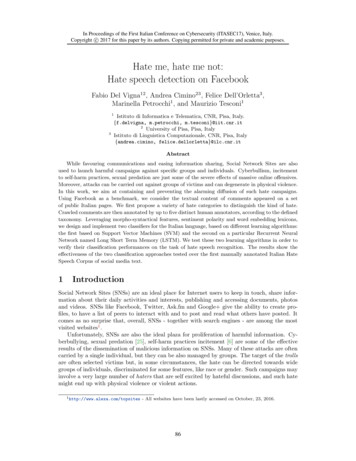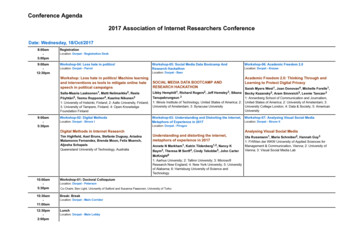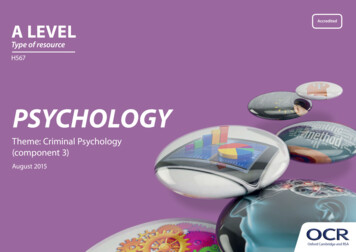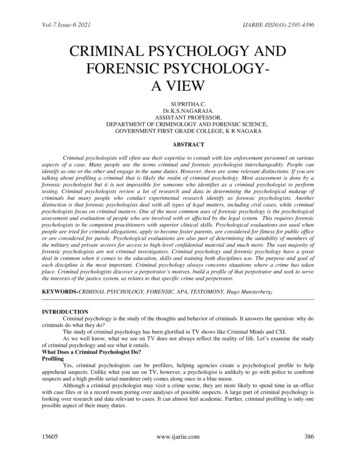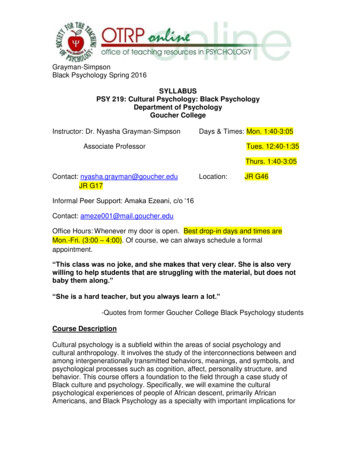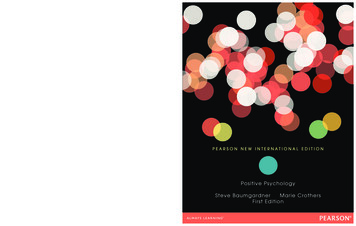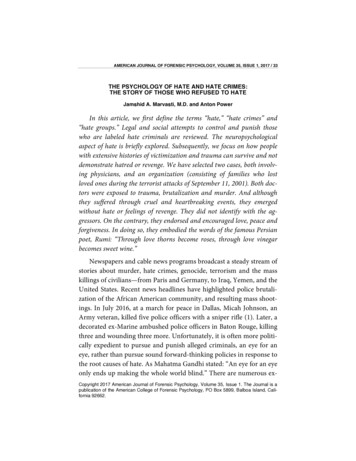
Transcription
AMERICAN JOURNAL OF FORENSIC PSYCHOLOGY, VOLUME 35, ISSUE 1, 2017 / 33THE PSYCHOLOGY OF HATE AND HATE CRIMES:THE STORY OF THOSE WHO REFUSED TO HATEJamshid A. Marvasti, M.D. and Anton PowerIn this article, we first define the terms “hate,” “hate crimes” and“hate groups.” Legal and social attempts to control and punish thosewho are labeled hate criminals are reviewed. The neuropsychologicalaspect of hate is briefly explored. Subsequently, we focus on how peoplewith extensive histories of victimization and trauma can survive and notdemonstrate hatred or revenge. We have selected two cases, both involving physicians, and an organization (consisting of families who lostloved ones during the terrorist attacks of September 11, 2001). Both doctors were exposed to trauma, brutalization and murder. And althoughthey suffered through cruel and heartbreaking events, they emergedwithout hate or feelings of revenge. They did not identify with the aggressors. On the contrary, they endorsed and encouraged love, peace andforgiveness. In doing so, they embodied the words of the famous Persianpoet, Rumi: “Through love thorns become roses, through love vinegarbecomes sweet wine.”Newspapers and cable news programs broadcast a steady stream ofstories about murder, hate crimes, genocide, terrorism and the masskillings of civilians—from Paris and Germany, to Iraq, Yemen, and theUnited States. Recent news headlines have highlighted police brutalization of the African American community, and resulting mass shootings. In July 2016, at a march for peace in Dallas, Micah Johnson, anArmy veteran, killed five police officers with a sniper rifle (1). Later, adecorated ex-Marine ambushed police officers in Baton Rouge, killingthree and wounding three more. Unfortunately, it is often more politically expedient to pursue and punish alleged criminals, an eye for aneye, rather than pursue sound forward-thinking policies in response tothe root causes of hate. As Mahatma Gandhi stated: “An eye for an eyeonly ends up making the whole world blind.” There are numerous exCopyright 2017 American Journal of Forensic Psychology, Volume 35, Issue 1. The Journal is apublication of the American College of Forensic Psychology, PO Box 5899, Balboa Island, California 92662.
34 / MARVASTI AND POWER: THE PSYCHOLOGY OF HATE AND HATE CRIMESamples of killings leading to more killings, but as Confucius warned,“If you plan for revenge, dig two graves.”Many psychologists consider hate an attitude or disposition because of its duration. Anger, on the other hand, is a temporary emotional state. Freud considered hate an ego state that wants to eliminatethe original source of its unhappiness (2). The Penguin Dictionary ofPsychology (3) defines hate as a “deep, enduring, intense emotion expressing animosity, anger and hostility toward a person, group or object.”News media follow crime victims for extended durations, neglecting to highlight those who forgave their offenders and refused to“hate.” In this article, we report on victims who did not seek revenge,refused to hate, and were not in denial of the victimization and traumaimposed upon them.HATE AND THE CONTEMPORARY WORLDA Native American parable tells the story of an elder who explainsto his grandson that two wolves live and fight inside our hearts—a wolfof love and a wolf of hate. The child asks which wolf will win. The elder replies, “The one that you feed.” This story emphasizes that each ofus has the ability for love, compassion and kindness, while also havingthe ability to restrain, reduce, and eliminate our disdain, aggressionand hate.After World War II and the horrific Nazi genocide, the expression“never again” became the rallying cry in response to the massacres ofWWII. However, numerous events over the last 70 years have proventhat “never again” is a dream. In the heart of Europe, Bosnian Muslimswere raped, tortured, placed in concentration camps, and murdered.In the Middle East, Israeli settlers kill Palestinians, and vice versa.Look no further than the Rwanda genocide, the 9/11 attacks, religiousextremists’ murders of physicians and nurses in abortion clinics (4),and the latest news of mass shootings in Florida, Texas and Louisiana.These sad events are clearly not accidents, nor are they random events.
AMERICAN JOURNAL OF FORENSIC PSYCHOLOGY, VOLUME 35, ISSUE 1, 2017 / 35Rather, they are premeditated hate acts perpetuated by hateful ideologies. With these events and more unfolding around the world, we believe focusing on the psychology and neurology of hate, hate groupsand haters is necessary, and institutions should make research on thesesubjects a priority.DEFINITION OF HATE CRIMELiterature defines hate crime as any felony/crime of violence toward a group of people that may be considered as an extreme expression of prejudice (5). Hate crime toward a population causes a tremendous amount of anxiety, fear, insecurity, and health problems inthe targeted population. Hate crimes are the consequence of a varietyof ideologies and beliefs. They appear to be on the rise, although it isestimated that 74% of hate crimes are still not officially reported to lawenforcement officials (6).UNDERSTANDING HATE CRIMESMuch of the literature in forensic psychology examines victims andthe emotional and physical harm incurred by the recipients of hatecrimes, racism and bigotry. The literature illustrates the hazards ofracism and hate crimes and the negative impact on the individual (thetarget), as well as the individual’s ethnic group and organization.Forensic psychologists testify regarding a victim’s possible psychosomatic harms, but appear far less likely to testify on behalf of offenders in court. However, the court may be interested to know the motivation and psychology of a suspected offender and the elements thatmay have contributed to the individual’s alleged crime. Moreover, forensic psychologists may be able to shed light on the mental stability ofthe offender, the capacity of the offender for rehabilitation, and therisk of committing future crimes.UNDERSTANDING PERPETRATORSUnderstanding is not justifying. From the point of view of forensicpsychology, examining the motivation of an offender enables us to
36 / MARVASTI AND POWER: THE PSYCHOLOGY OF HATE AND HATE CRIMESexplore what drives hate crimes and racism. This understanding inturn enables us to consider how to decrease or possibly prevent futurecriminal activities.The clinical literature indicates that people tend to see groups thatthey are not part of as more homogenous than their own group.Individualities and personal characteristics are not considered and themembers of other groups are assumed to be the same. Moreover,people have a tendency to mistrust those who are not part of their owngroup.The Los Angeles Police Department, with the help of psychologistEdward Dunbar (7), examined 550 hate crime offenders, discoveringthat, while they lacked the clinical features of psychosis orschizophrenia, they were disturbed individuals who posed a high levelof risk to the community and a tendency for violence. Their childhoodhistories contained a high frequency of abuse by caregivers, includingviolence as a solution to family conflicts. Preexisting unresolvedchildhood hostility may be directed at a group or race toward whomsociety already exhibits negative feelings.THE SEVEN-STAGE HATE MODELSchafer and Navarro (8) wrote about the seven stages of hatecrimes as a model to understand what an offender may endure beforecommitting violence. These are:Stage 1: The Haters GatherStage 2: The Hate Group Defines ItselfStage 3: The Hate Group Disparages the TargetStage 4: The Hate Group Taunts the TargetStage 5: The Hate Group Attacks the Target without WeaponsStage 6: The Hate Group Attacks the Target with WeaponsStage 7: The Hate Group Destroys the TargetA group of researchers joined a white racist chat room to studywhy some chat room members developed negative attitudes toward
AMERICAN JOURNAL OF FORENSIC PSYCHOLOGY, VOLUME 35, ISSUE 1, 2017 / 37another group with a different ethnic background. The researchersposted fake and fabricated comments about the objectives of blackpeople, such as moving into white neighborhoods, marrying whitewomen, taking white people’s jobs, etc. The researchers discoveredthat the closer black people came to “invading white territory,” themore violent their responses became. The most extreme commentswere connected to a threat to the white cultural integrity, such asmarrying a white woman, rather than losing jobs to blacks (7).THE PSYCHOLOGY OF HATE CRIMESClinical literature speculates that offenders may be classified interms of their motivations for committing hate crimes as follows (9,10):1.2.3.4.Thrill seeking offendersDefensive offendersMission offendersRetaliatory offendersThrill seeking offenders are looking for excitement—at someoneelse’s expense—by destroying property and harassing minorities, oftenthrough brutal physical attacks. Further, they want to exercise theirpower to gain status and prestige among their peer groups who encourage hatred.Defensive offenders commit hate crimes to protect or defend theircommunity or way of life that, in their view, is being threatened, simply by the presence of a different group.Mission offenders are those who are attached to their prejudiceand ideology, which becomes a mission to get rid of all members of aparticular group of people, believing them to be evil and subhuman.Examples of this group are the Ku Klux Klan and National Alliance.Retaliatory offenders commit hate crimes in response to a perceived or actual hate crime. This attack could be motivated by a rumor,before even being verified for accuracy (9, 10).
38 / MARVASTI AND POWER: THE PSYCHOLOGY OF HATE AND HATE CRIMESA feeling of self-hate may motivate a person to restore his/hersense of significance through action and, as psychologist Arie Kruglanski indicates, the most powerful and primitive act that one can take toshow his/her power over another is violence (11). This dynamic hasbeen studied for years in rapists, as it is evident that the motivation formany rapes is to control/dominate/subdue someone via violence andintimidation. Hatred toward oneself is displaced toward others, an egodefense mechanism in psychoanalysis called “splitting and projection.”We “split” the part we don’t like about ourselves and “project” it toward others. By destroying the “other,” we also symbolically get rid ofthe part we hate about ourselves. For example, in the Orlando gaynightclub shooting, the father of Omar Mateen, the killer, reportedthat his son had recently become enraged when he saw two men kissing. Later on, it was reported that Mateen frequently visited the gayclub he targeted, and used gay dating apps.Adam Waytz from Northwestern University indicated that as people become more socially or emotionally attached/connected to agroup, the more they believe that others outside of the group are lessintelligent, even less human (11).One interesting contradictory study of 169 cases of hate crime bythe Boston Police Department found that the most common motivation behind hate crime was in fact the “excitement” and “thrill” of violence, while the least reported reason was the offender’s idea that thevictim belonged to an inferior group (10).NEUROLOGY OF HATEAlthough poets and artists fantasize that love comes from theheart, science has proven that strong emotions (love, hate, sexualdrive) emerge from the brain. In 2008, Professor Semir Zeki (12)scanned the brains of 17 subjects while they gazed at images of peoplethey hated. Certain areas of the brain activated, such as the medialfrontal gyrus, right putamen, premotor cortex and medial insula.These brain regions are now called collectively the “hate circuit,” and
AMERICAN JOURNAL OF FORENSIC PSYCHOLOGY, VOLUME 35, ISSUE 1, 2017 / 39they are also involved in the initiation of aggression. But the feeling ofaggression and feeling of anger, fear and danger show different patterns in the brain than hatred does (12).Another interesting finding in the neurobiology of the brain is thatlove seems to deactivate brain areas that are associated with judgment,while hatred traditionally activates areas of the frontal cortex that maybe responsible in evaluating another person and predicting their behavior. There are also some commonalities between love and hate inthe subcortical areas of the brain. The putamen and insula which areactivated by hate are the same ones that are activated by romantic love.According to neurobiologist Zeki and colleagues, “this linkage mayaccount for why love and hate are so closely linked to each other inlife” (13).HISTORY OF THE LEGISLATION OF HATE CRIMEThe Civil Rights Act of 1964 outlawed discrimination based onrace, color, religion, sex, or national origin. It ended unequal application of voter registration requirements and racial segregation inschools, public places, and at the workplace (14). However, one maycommit a hate crime without the intent of interfering with anotherperson’s federal rights. In 1990, the government defined hate crimes inthe Hate Crime Statistics Act (HCSA) and mandated that the attorneygeneral’s office collect statistical information on the subject (15). TheHCSA’s primary goal was not to define hate crimes, but to mandategathering statistics. The definition of hate crime itself has several ambiguities as it does not indicate what specific act should be construed ahate crime. It is not clear if the criminal behavior should be directedagainst the victim or personal property. Also, another ambiguity isconnected to the word “prejudice,” as it is not clear if all prejudicialactivities should be considered hate crimes. In 1994, the implementation of the Violent Crime Control and Law Enforcement Act and in2009, the Matthew Shepard and James Byrd Jr. Hate Crimes Prevention Act expanded on existing hate crime law, and dropped the re-
40 / MARVASTI AND POWER: THE PSYCHOLOGY OF HATE AND HATE CRIMESquirement that victims have to be involved in federally protected activity (14).POLICY IMPLICATIONS IN THE UNITED STATESFederal law (18 U.S.C. § 249) states that hate crimes are felony violent acts that are directed toward individuals because of their race, color, religion or national origin. The Local Law Enforcement HateCrimes Prevention Act of 2007 (H.R. 1592) and the Matthew ShepardLocal Law Enforcement Hate Crimes Prevention Act of 2007 (S. 1105)were passed by Congress to extend coverage to those victimized due totheir gender, gender identity, sexual orientation and disability.Case examples of highly publicized hate crime victims in the United States include:1. James Byrd Jr., a 49-year-old black man, was dragged behind a pickup truck by three white males, at least two ofwhom were white supremacists.2. Matthew Shepard, an American student at the University ofWyoming, was kidnapped outside a known gay establishment by two strangers, pistol whipped, tied to a fence, tortured, and murdered.3. David Ritcheson, an 18-year-old Latino, was attacked bytwo white teens (racially motivated), beaten, sodomizedwith an umbrella stand, and left unconscious. He testifiedbefore Congress about his experience, calling for an expansion of hate crime legislation. He later committed suicide.EXAMPLE OF RELIGIOUS HATE GROUPSTwo private establishments monitor hate groups in the U.S.: TheAnti-Defamation League (ADL) and the Southern Poverty Law Center(SPLC). The Southern Poverty Law Center (SPLC) considers severalreligious groups to be hate groups. A few of them are:1. The Nation of Islam is considered by SPLC a “black separatist” group. They reportedly preach that a black scientist
AMERICAN JOURNAL OF FORENSIC PSYCHOLOGY, VOLUME 35, ISSUE 1, 2017 / 41named Yakub created the white race, a “race of devils,” onthe Greek Island of Patmos. The Nation of Islam is not regarded as a legitimate branch of any religion by the mainstream Muslim community (16, 17).2. The Creativity Movement (formerly called the WorldChurch of the Creator) is considered by SPLC a white supremacist group and is involved with violence and bigotry.3. The Westboro Baptist Church is also designated as a hategroup due to their stance against homosexuality and againstthe United States (18). Many gay rights opponents andsupporters have condemned this organization.THOSE WHO REFUSE TO HATEIzzeldin Abuelaish, M.D.Dr. Izzeldin Abuelaish was a physician who lived and worked inthe Gaza Strip. The Israeli army shelled his home in the Gaza Strip,killing three of his daughters and his niece. Afterward, he wrote abook, I Shall Not Hate (19). Elie Wiesel, a Nobel Peace Prize Laureateand Holocaust survivor, is quoted on the cover of the book—“This story is a necessary lesson against hatred and revenge.” President Cartercommented: “In this book, Dr. Abuelaish has expressed a remarkablecommitment to forgiveness and reconciliation that describes the foundation for a permanent peace in the Holy Land.” Dr. Abuelaish’s bookwas translated into 20 different languages and became an internationalbestseller. Throughout the book, he explains that he selected a “road topeace and human dignity.” He was nominated for three consecutiveyears for the Nobel Peace Prize.The book contains his and his family’s biography: A Palestiniandoctor with a degree from Harvard, he was born and raised in a refugee camp in the Gaza Strip, and as a physician treated patients on bothsides of the line. His response to his tragedy made news and won himhumanitarian awards around the world. Instead of seeking revenge or
42 / MARVASTI AND POWER: THE PSYCHOLOGY OF HATE AND HATE CRIMESsinking into hatred, Abuelaish called for the people of the region tostart talking to each other. His deepest hope is that his daughters willbe “the last sacrifice on the road to peace between Palestinians and Israelis.”He thinks about his three daughters every day and created a foundation in their memory. Daughters for Life is a Canadian charity thatprovides the opportunity for young women to develop a strong voiceand play a more influential role in improving the quality of life.What elements in Dr. Abuelaish’s life or personality contributed tohis lack of revenge and hatred toward the killers of his family? To explore this, we would like to quote from Dr. Marek Glezerman, chairman of the Hospital for Women in Israel, who has been involvedclosely with Dr. Abuelaish for years. He wrote a foreword for his bookand disclosed some qualities of Abuelaish’s personality and attitude:“ Izzeldin visited our home a few weeks before the Israel DefenseForces began the bombardment of Gaza, and later we talked on thephone as shells were falling. I asked him how he was handling his lifeunder the bombing, living under constant curfew with his children athome.”Dr. Abuelaish responded:Like everyone else, we are all sleeping in the same room. Weput some children against one wall and some against anotherwall so if we’re hit we won’t all be wiped out.Dr. Marek Glezerman continued:On January 16th, 2009, three of his girls were on the wrongwall. After this tragedy, who would have blamed him if he hadbeen taken over by revenge and contempt? A small group ofinfluential Israelis asked for a formal investigation into the attack of Izzeldin’s house, and the Ministry of Defense respondedby stalling and evasion. Izzeldin has every reason to be frustrated, disappointed, and offended by the environment he’slived in, but he is not. Despite everything he has seen and gone
AMERICAN JOURNAL OF FORENSIC PSYCHOLOGY, VOLUME 35, ISSUE 1, 2017 / 43through, his belief in coexistence and in the peace process between Palestinians and Jews remains unshaken. I never heardhim condemn the injustices he suffered in general but only inspecific, focused ways. The attitude is also reflected in his optimistic outlook on life: he seems devoid of any existential pessimism or hopelessness.On January 19, 2011, Amy Goodman interviewed Abuelaish forDemocracy Now (20). As Goodman reported, during Israel’s brutal 22day assault on Gaza “ up to 1,400 Palestinians and 13 Israelis werekilled. more than half the Palestinians killed were civilians, over 300of them children.” Two days before the end of the assault, Dr.Abuelaish’s home was shelled twice by Israel tanks. In addition to thedeaths of three daughters and a niece, Abuelaish’s other daughter, Shatha, and his brother were also badly injured. Shatha lost her eye. AsAmy Goodman reported “ No ambulances ever reached Dr.Abuelaish’s home, which was surrounded by Israeli tanks. He and thesurviving members of his family walked a quarter of a mile carryingthe dead and wounded through the streets. They eventually found anambulance to take them to the closest hospital. Standing outside, agrieving Dr. Abuelaish kissed the forehead and hands of his children asthey were strapped onto stretchers. He addressed a news camera at thescene in Hebrew.Abuelaish stated that he knows how much he has lost, and thatthey will never come back, “ but as a physician and a Muslim of deepfaith, I need to move forward to the light, motivated by the spirits ofthose I lost ”September Eleventh Families for Peaceful TomorrowsFollowing another event that sparked anger and hatred in thehearts of Americans, an organization was created for the families wholost loved ones. These families joined together and created an organization against revenge and retaliation. Interestingly, this is the exactopposite approach that our leaders took us in as we entered an endless
44 / MARVASTI AND POWER: THE PSYCHOLOGY OF HATE AND HATE CRIMESwar. The name of this organization is September Eleventh Families forPeaceful Tomorrows. Their name comes from a statement made byMartin Luther King, Jr., “Wars are poor chisels for carving out peaceful tomorrows.” According to their website:The vision for September 11th Families for Peaceful Tomorrows was born when a small group of family members of thosekilled on 9/11 became connected after reading each other’spleas for nonviolent and reasoned responses to the terrorist attacks. Several of these individuals met one another when theyparticipated in the ‘Walk for Healing and Peace’ from Washington, D.C. to New York City in late 2001 (21).In January of 2002, four family members traveled to Afghanistanto witness the consequences of U.S. military action there and to express their profound concern that high numbers of civilian casualtieswould increase terrorist recruitment rather than making the U.S. orthe world safer.These families believe that the violence that took their loved ones’lives could spin out of control, and fear could be manipulated by politicians and the media to justify foreign and domestic policies thatwould increase violence while decreasing U.S. citizens’ rights and liberties.Ebrahim Amanat, M.D.The late Dr. Ebrahim Amanat practiced psychiatry for more than30 years in the United States before his death. He is the author of TheMiracle of Love: A Spiritual Approach to PTSD (22) and Suffering andSpiritual Growth, Calamities and Providence: from Trauma to Peace,Tranquility, Sanity and Dignity (23). During the course of his career,he treated thousands of trauma victims who experienced a wide rangeof incidents, from rape to the tragedies of war. In his personal life,Amanat endured substantial trauma, abuse, assaults and threats ofdeath in Iran due to his Bahá’í faith. But he overcame his fear of andhate toward aggressors by using love/spirituality/faith/meditation/op-
AMERICAN JOURNAL OF FORENSIC PSYCHOLOGY, VOLUME 35, ISSUE 1, 2017 / 45timism/hope/forgiveness and his own interpretation of trauma, oftensaying: “My calamity is my providence, outwardly it is fire and vengeance, but inwardly it is light and mercy.” Amanat was able to transform his PTSD symptoms into peace, tranquility, serenity, and dignity.“The more you learn to love and care for fellow sufferers of PTSD, thefarther and greater your own recovery. This is the miracle of love,” hesaid. Amanat was in fact able to recover from his own PTSD by helping others with the same condition.Dr. Amanat’s Traumatic LifeDr. Amanat was born and raised in a loving family in Iran. Hisparents were Jewish and eventually converted to the Bahá’í Faith,which was considered heretical and a cult by a number of religiouspeople in his community. He wrote that converting to the Bahá’í Faithput his family in mortal danger, at risk of death or annihilation. Hismother was the daughter of a Sephardic Jewish rabbi, and converted tothe Bahá’í Faith following a dream in her youth.Considered by many to be members of the “misguided sect,” theAmanats were constantly harassed, abused, threatened, persecuted andassaulted. Amanat reflected on his experiences, writing “ the personal experiences of multiple trauma during my own childhood andyouth, unveiled to me the significance of spirituality on trauma resolution as they are the two sides of one coin.”How was Amanat able to overcome his PTSD, fear, and the strongdesire to hate and seek revenge or retaliation? In a review of his writings, it appears that his faith was a source of great strength for him.During his early life, his loving family supported each other as theyendured outside trauma and brutalities. Amanat wrote, “We had become totally interdependent. I soon realized that it was easier for me totalk about ‘us’ rather than ‘me.’ All things became ‘ours’ I let go ofthe illusion of self.” He indicated that his traumatized family membersendured their nightmares, fears, paranoia and agitation with less longterm effects as a close-knit family unit. Later as a doctor, he used posi-
46 / MARVASTI AND POWER: THE PSYCHOLOGY OF HATE AND HATE CRIMEStive psychotherapy and spiritual psychiatry in his treatment of traumavictims.Amanat reflected in his writings on the passing of his father, whenhe was 14. “ he had left me forever wondering what he wished me todo. I frantically cried, as my mother tried to calm me.” His father hadshared many enchanting tales, which became the bedrock of Amanat’sdevelopment. He could reenter a state of innocence by recalling a tale,shedding his cynicism, “looking at the world through the loving spiritof my father.”Fred, a Vietnam Veteran with PTSDDr. Amanat’s psychotherapy with Fred, a Vietnam War veteransuffering from PTSD, hate, fear and urges to do harm, appears to haveserved as a cathartic experience for Dr. Amanat. Both patient andtherapist discovered that war can destroy the soul of participants. AsAmanat indicated:Warriors who do not lie to themselves often report that their experiences of killing were arousing and addictive. At times, sucharousal consummated in unnecessary or random killing. The socalled ‘adrenaline rush’ of combat has turned up in studies of gangviolence, police brutality and other incidents in subcultures thatsanction killing (22).Eric Fromm (24) wrote that one of the consequences of war is“necrophilic violence,” which indicates a pleasure in killing or abuse.This phenomenon generates a feeling of power, a craving to experiencedanger and a deviant interest in atrocities in the offenders.Amanat shared some of Fred’s statements during individual andgroup therapy sessions: I enjoyed killing Even if they were civilians, it didn’t matterto me. We didn’t know who ‘Cong’ was and who wasn’t. Sometimes I just went berserk I started to enjoy the act of killingon my own I felt powerful and ruthless. I didn’t listen tothose folks cry. To me they were not real humans or children
AMERICAN JOURNAL OF FORENSIC PSYCHOLOGY, VOLUME 35, ISSUE 1, 2017 / 47 I was not alone in doing that. I feel so many men are savagekillers like me. [Amanat wrote that at this point Fred burst intotears.]Nietzsche warned that in fighting a monster, one should be carefulnot to become a monster. After a long involvement in a therapeuticrelationship with Dr. Amanat (another victim of PTSD), Fred began to“de-identify with aggressors” and began to identify with his healer andovercome PTSD and hate. The monster became a human being.Amanat treated numerous combat veterans during his many yearsat a Veterans Affairs hospital. He wrote, “excruciating combat experiences can destroy the self-image, changing one from a loving, mercifulbeing into a psychotic individual with sadistic thoughts. This processof going mad signifies self-alienation. It occurs as a breakdown of selfimage and a reaction to unbearable pain. In such circumstances wemay exercise profound alterations in personality, body image, ideals,values, and a sense of coherence. Even years after combat experience,many soldiers cannot return to their original identity. They still carrythe psychotic split ”Fred was one such soldier; he received a tremendous amount ofhelp from his physician, himself an “injured healer” who was healedand dedicated his life to trying to cure others. While Amanat did notparticipate in the Vietnam War, the war had come to him.DISCUSSIONIt seems that in the case of both physicians, their religion had animportant influence on them and was their guide, mentor and directorof their thinking, feelings and behavior.Religion may have an impact on faithful individuals and directsome toward war and killing, and others into peace, forgiveness andmercy. The following example is a demonstration of both sides of theseopposing feelings: In November, 2015 in Meriden, Connecticut, TedHakey Jr. took his gun and shot at the Meriden Muslim Mosque. He
48 / MARVASTI AND POWER: THE PSYCHOLOGY OF HATE AND HATE CRIMESwas arrested and, although no one was hurt because he was shootingonly at the building, Hakey was sentenced to six months in prison. Thefederal judge indicated that shooting at a religious institution cannotbe tolerated and it was considered a hate crime. He was sentenced despite a plea of leniency from the president of the mosque, Dr. Qureshi,who stated, “Mr. Hakey should not be made an example of to deterfuture actions of this
Edward Dunbar (7), examined 550 hate crime offenders, discovering that, while they lacked the clinical features of psychosis or schizophrenia, they were disturbed individuals who posed a high level of risk to the community and a tendency for violence. Their childhood histories contained a high frequency of abuse by caregivers, including .



